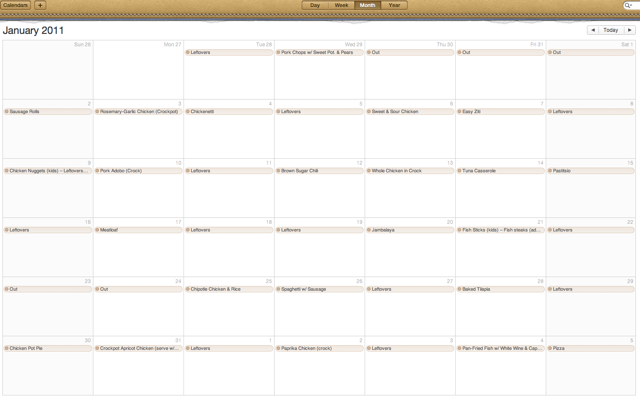Talking about Shopper (and my compulsion to be ultra-organized about grocery shopping) reminded me of one of my other compulsions: making a menu plan for dinners.
A long time ago, I tried out FlyLady to help organize my life a bit. I failed at a lot of the plan, but one thing that stuck with me was the idea of making a dinner menu for a week, two weeks, or even a month at a time.
I hated when I would get to 5:30 (or later!) and realize that I had no clue what I would feed the family for dinner. Not only that, but I would also realize at that moment that whatever I could feed them was likely frozen and was not going to defrost in time (or well, if I used the microwave) for us to eat before bedtime.
So I started to write a menu for the next week and plan out our meals.
At first, I over-cooked and didn’t plan on leftovers often enough, but eventually I got the hang of how often we could eat leftovers to prevent me from doing what I had been tending to do for years: go through the fridge every few weeks, find the food that we’d forgotten was in the fridge and throw it out before it became sentient and attacked us all.
I had a good record of getting to the food before it got to us, but I really hated throwing away what used to be perfectly good food whose only crime was that we forgot about it for a week or two. And it grew hair. And possibly legs, though no one has ever really been able to prove that about those baked beans.
Ahem.
Once I got the hang of doing a menu for one week, I pushed myself to do it for two. I realized that if I wrote activities down on my calendar, I’d remember when we were going to be out late (crockpot night!), when we were going to a banquet (don’t cook when we’re having pizza with the soccer team!), and when my husband was out of town (cook less often and eat a lot of leftovers).
Then I started getting fancier with my dinner menu calendar: I’d write down the cookbook and page number of the recipe. When I was counting points with Weight Watchers, I’d write down how many points dinner would be so I could budget the rest of my day’s points.
Pretty soon, I also noticed that there were way fewer incidents with leftovers that resembled gladiator games, too, because we were eating them before they went bad.
After a while, I was doing five weeks at a time! And I realized something: my grocery budget was cut by around 30% just because I knew what I was going to be cooking that week.
Before I went shopping, I would pull out my cookbooks, check ingredient lists for the week, and add what I needed. Once I got to the store, I’d buy what I needed and little else.
I was no longer buying a bunch of chicken just because it was there and I was pretty sure I’d be able to figure out something to do with it, but I was buying it because I had two chicken dishes I was making this week and I knew how much I needed.
I wasn’t starting a recipe for Jambalaya only to realize that I was out of rice and would need to buy that little package around the corner that was three times the price per pound that it is at Sam’s.
And, because I was posting the menu on the fridge, when I got the “what’s for dinner?” question from everyone two or three times a day, I could just point at the menu and grunt. (This is especially important if I haven’t had my coffee yet.)
But pretty soon, I was finding that sitting and writing the menu out again and again was time-consuming and was also giving me writer’s cramp. Yuck.
So one day, I decided to use my computer’s calendar to keep track of the menu. The Dinner Menu has its own calendar on my computer, and when I’m being really good about it, it can look like this on the desktop:
I’ve also found that the longer I’ve been using this method, the less often I have to actually type in the information. I can simply search for a recipe on past calendars and copy/paste it onto the day I’m planning on making it again.
I can even print it out in a list form that will show notes about the menu, including which cookbook it’s in and how many WW points I’m using for it. That’s actually the one I usually post on the fridge now.
This isn’t to say that I’m never moving things or just crossing something off because we wound up with a last-minute change, but by simply having a plan, my grocery list stays organized, I remember to defrost the pork chops in time to make them, and I don’t hear “what’s for dinner?” nearly as often as I used to.
The biggest benefits happen at the grocery store when I know what I’m buying (less time there) and I stick with my list (less money spent)!
Which all reminds me…it’s time to write another menu. Later!
Copyright 2012 Christine Johnson
About the Author

Christine Johnson
Christine Johnson has been married to Nathan since 1993 and is the mother of two homeschool graduates. She and Nathan live in the Blue Ridge Mountains of Southwest Virginia, where she tries to fit in as a transplanted Yank. She blogs at Domestic Vocation about her life as a wife, mother, and Lay Dominican.




.png?width=1806&height=731&name=CatholicMom_hcfm_logo1_pos_871c_2728c%20(002).png)
Comments